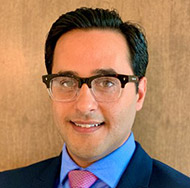Written by Ayden Jacob, BA, MSc
Edited by Gregg Khodorov, MD MBA, and Varun Danda, BS
The Importance of Early Exposure to Radiology: The Medical Student Perspective
 Ayden Jacob, BA, MSc |
Ambitious. Curious. Empathetic. These adjectives describe medical students as they don their new white coats and begin a lifelong journey into the world of medicine. Throughout the formative years of medical school, students spend a significant amount of time memorizing complex biochemical pathways, understanding the nuances of pathologies and mastering anatomy. As they transition into clerkship years, they begin practicing the art of medicine. In being exposed to fields such as surgery, pediatrics, obstetrics and gynecology, and family medicine, students form opinions as to what practicing medicine means to them. More importantly, it is through experiencing these specialties that students develop an affinity for the one domain of medicine they may choose to pursue as their future careers.
Conventionally, most medical students have minimal exposure to the field of radiology. Currently, there is no formally required clerkship in radiology, and being exposed to radiology in pre-clinical years is quite rare. Simultaneously, as medical students navigate the complexities of the healthcare system and finding their joy in a particular field, there is a growing angst about the future of radiology. Will AI overtake the future of radiology? Will the field dynamically change due to encroachment? Through introducing the field of radiology to medical students early on in their careers, students gain a fair understanding of what being a radiologist truly entails. Furthermore, a deeper appreciation for the nuances surrounding the field is afforded to students, thereby empowering them to make the best career choice for themselves.
Understanding the AI Hype
The advent of inculcating AI in healthcare has catalyzed a transformation within the field of precision medicine, diagnostics and informatics. Perhaps more than any other field in medicine, radiology has embraced the introduction of AI into clinical practice. To medical students without exposure to radiology in a clinical setting, AI may be viewed as a potential threat to the future of the job market. A medical student with early exposure to radiology will appreciate that advances in machine learning will only augment their capabilities as a future radiologist. Through early education in radiology, AI transforms from a foe to an ally.
Encroachment in Radiology
Beyond the fear of AI negatively impacting the future job market of radiologists, medical students may also stray away from pursuing radiology due to potential interprofessional encroachment issues within the field. However, by educating themselves as to the nuances involved in other healthcare professionals’ contributions to the field, medical students can better decide for themselves whether this threat is substantiated. More importantly, though, by educating medical students about the economics of these issues, it may inspire them to pursue research careers in health policy within radiology.
Patient Engagement and Varying Career Paths
A common misperception within the medical student community is that radiology is a field confined to the reading room. By involving medical students in radiology-based research projects, students may quickly learn how imperative radiology is to the vitality of the hospital system and patient outcomes. Most students are unaware that radiologists can aptly enter the industry to work on health system improvements, informatics, AI development and clinical operations management. Furthermore, within radiology, many subspecialties afford opportunities for direct patient contact.
A Love for Engineering, Technology and Anatomy
Radiology continues to attract the best and brightest of medicine. There is a unique blend within radiology that may not exist in other fields of medicine: the synthesis of engineering, technology and medicine coming to life daily to improve the lives of patients. Early introduction of students to radiology’s role within the healthcare system, and its immediate impact on patient care, may inspire students to pursue a career in this wonderful specialty.